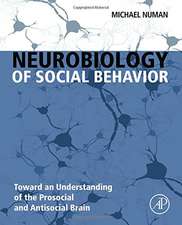Modeling the Psychopathological Dimensions of Schizophrenia: From Molecules to Behavior: Handbook of Behavioral Neuroscience, cartea 23
Editat de Mikhail Pletnikov, John Waddingtonen Limba Engleză Hardback – 16 noi 2015
This book describes the current understanding of the clinical and pathological features of schizophrenia, with a particular focus on the evolving conceptualization of schizophrenia and related diagnostic categories of psychotic illness as combinations of dimensional abnormalities. It provides an overview of modern strategies for generating cellular and whole animal models of schizophrenia as well as detailed reviews of the specific experimental preparations and paradigms aimed at molecular, developmental, and brain-network mechanisms that are the underlying aspects of abnormal behavior and various aspects of schizophrenia.
This groundbreaking book is an authoritative overview of the translational impact of emerging clinical insights on basic research approaches in schizophrenia that will advance the reader’s understanding of the five major dimensions of psychopathology in schizophrenia and related psychoses and resolve the genetic and neurobiological underpinnings of these dimensions.
- Includes reviews of animal models that capture the most recent insights into the etiology and pathogenetic mechanisms of schizophrenia, with an emphasis on the translational potential of these models
- Contains a series of reviews of recently available cellular models for analysis of signaling pathways and gene expression, which complement behavioral neuroscience research in schizophrenia
- Edited and authored by leading researchers in the field of schizophrenia and related psychoses
Preț: 760.44 lei
Preț vechi: 1003.07 lei
-24% Nou
Puncte Express: 1141
Preț estimativ în valută:
145.52€ • 155.60$ • 121.32£
145.52€ • 155.60$ • 121.32£
Carte tipărită la comandă
Livrare economică 10-24 aprilie
Preluare comenzi: 021 569.72.76
Specificații
ISBN-13: 9780128009819
ISBN-10: 0128009810
Pagini: 548
Dimensiuni: 216 x 276 x 30 mm
Greutate: 1.72 kg
Editura: ELSEVIER SCIENCE
Seria Handbook of Behavioral Neuroscience
ISBN-10: 0128009810
Pagini: 548
Dimensiuni: 216 x 276 x 30 mm
Greutate: 1.72 kg
Editura: ELSEVIER SCIENCE
Seria Handbook of Behavioral Neuroscience
Public țintă
Researchers and graduate students in clinical neuroscience, translational neuroscience, behavioral neuroscience, neurobiology, clinical psychiatry, and pharmaceutical scienceCuprins
Part I: From Clinical Dimensions to Animal Models
Clinical and Pathological Aspects
1. Overview of Schizophrenia: Dimensions of Psychopathology
2. Overview of Schizophrenia: Epidemiology and Pathobiology
Animal Models of Psychotic Disorders: Dimensional Approach
3. Overview of the Dimensional Approach in Basic Research
4. Modeling Positive Symptoms
5. Modeling Negative Symptoms
6. Modeling Cognitive Impairment
7. Modeling Affective Symptoms
Part II: Neurobiology of Psychotic Disorders
Non-Genetic Models
8. MAM-Related Models
9. Social Isolation Models
10. Pharmacological/Substance Abuse Models
11a. Etiological Environmental Models: Maternal Immune Activation
11b. Etiological Environmental Models: Viral Infection Models
11c. Etiological Environmental Models: Stress Models
12. Toxoplasma Models
13. Nutritional Alterations
Genetic Models
14a. Mouse Models: Risk Genes
14b. Mouse Models: CNV Models
15. Rat Models
Gene-Gene and Gene-Environment Models
16. Gene-Gene Models
17. Gene-Environmental Models
18. Rodent Models of Multiple Environmental Exposures with Relevance to Schizophrenia
Cell Models
19. Synaptic Abnormalities and Neuroplasticity
20. iPS Models
21. Olfactory Epithelium and iN Models
22. Neuron-Glia Interaction
Molecular Studies
23. Intracellular Signaling
24. Hormones
25. Oxidative Stress
26. Immune Dysregulation; Autoantibodies
27. Future Directions
Clinical and Pathological Aspects
1. Overview of Schizophrenia: Dimensions of Psychopathology
2. Overview of Schizophrenia: Epidemiology and Pathobiology
Animal Models of Psychotic Disorders: Dimensional Approach
3. Overview of the Dimensional Approach in Basic Research
4. Modeling Positive Symptoms
5. Modeling Negative Symptoms
6. Modeling Cognitive Impairment
7. Modeling Affective Symptoms
Part II: Neurobiology of Psychotic Disorders
Non-Genetic Models
8. MAM-Related Models
9. Social Isolation Models
10. Pharmacological/Substance Abuse Models
11a. Etiological Environmental Models: Maternal Immune Activation
11b. Etiological Environmental Models: Viral Infection Models
11c. Etiological Environmental Models: Stress Models
12. Toxoplasma Models
13. Nutritional Alterations
Genetic Models
14a. Mouse Models: Risk Genes
14b. Mouse Models: CNV Models
15. Rat Models
Gene-Gene and Gene-Environment Models
16. Gene-Gene Models
17. Gene-Environmental Models
18. Rodent Models of Multiple Environmental Exposures with Relevance to Schizophrenia
Cell Models
19. Synaptic Abnormalities and Neuroplasticity
20. iPS Models
21. Olfactory Epithelium and iN Models
22. Neuron-Glia Interaction
Molecular Studies
23. Intracellular Signaling
24. Hormones
25. Oxidative Stress
26. Immune Dysregulation; Autoantibodies
27. Future Directions






















